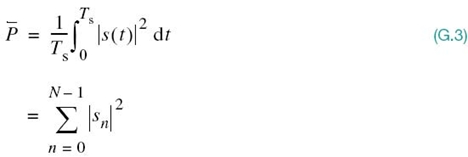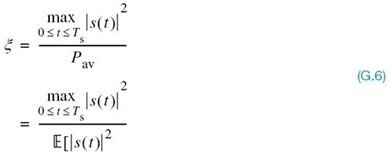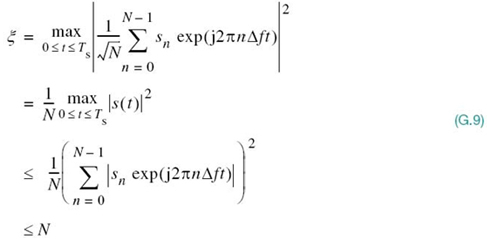APPENDIX
G The Peak-Power Reduction Problem in OFDM
In Section 9.11 we discussed the multicarrier transmission technique, namely orthogonal frequency-division multiplexing (OFDM), which is of particular importance to wireless communications due to the computational benefits offered by the fast Fourier transform (FFT) algorithm. However, envelope variations are a frequently cited drawback of OFDM because of the peak-power limited problem. This problem arises due to the statistical possibility of a large number of independent subchannels in the OFDM becoming constructively superimposed, thereby resulting in high peaks. In the literature, the practical issue of envelope variations is described in terms of the peak-to-average power ratio, commonly abbreviated as PAPR.1
In this section, we discuss the PAPR problem in wireless communications and how it can be reduced.
G.1 PAPR Properties of OFDM Signals
Consider a single modulation interval, that is, a single symbol of OFDM, the duration of which is denoted by Ts. In its most basic form, the transmitted OFDM signal is described by
where the term Δƒ denotes the frequency separation between any two adjacent subchannels in the OFDM. By definition, the frequency separation Δƒ and symbol duration Ts are related by the time−bandwidth product:
This condition is required to satisfy the orthogonality requirement among the N subchannels of the OFDM.
Typically, the coefficients in OFDM, denoted by sn in (G.1) are taken from a fixed modulation constellation, exemplified by M-ary phase-shift-keying (PSK) or M-ary quadrature amplitude modulation (QAM) techniques, which were discussed in Chapter 7. With s(t), in its baseband form, being a complex-valued signal with an amplitude and phase that characterize it, we may express the time-averaged power of an individual symbol of the OFDM signal in (G.1) as follows:
where the summation in the second line of the equation follows for Parseval’s theorem, discussed in Chapter 2. With the OFDM coefficient sn being a random variable, which it is in a wireless environment, it follows that the time-averaged power ![]() is itself a random variable. It follows therefore that the ensemble-averaged power of the OFDM signal is given by the expectation
is itself a random variable. It follows therefore that the ensemble-averaged power of the OFDM signal is given by the expectation
In an OFDM signal based on M-ary PSK, for example, we have |sn| = 1 for all n. In this special case, (G.4) yields
As pointed out previously, the metric of interest commonly used in the literature for assessing the issue of statistical peak-power variations in the use of OFDM for wireless communications is the peak-to-average power ratio (PAPR), for which we offer the following definition:
where, in words, the term in the numerator denotes the maximum value of the instantaneous power (i.e., peak power) of the OFDM signal measured across the symbol interval, 0 ≤ t ≤ Ts, and the denominator denotes average power, hence PAPR. The formula used in (G.6) refers to the baseband formulation of the PAPR problem.2
Recognizing that PAPR is, in reality, a random variable distributed across each OFDM symbol, a statistical interpretation of it is useful. To this end, we may express the probability of the event that an OFDM symbol, denoted by s(t) as defined in (G.1), exceeds the peak value ξp with probability Pc as follows:
To expand on this definition, we say that the PAPR is less than some prescribed value ξp for 100(1 – Pc) of the OFDM symbols, in which case we may refer to 100(1 – Pc) as a percentile PAPR.
G.2 Maximum PAPR in OFDM Using M-ary PSK
Consider an OFDM system based on M-ary PSK for its modulation scheme. For this special application of OFDM, the PAPR is always less than or equal to N, where N is the number of subchannels. To justify this statement, we first note that for M-ary PSK,
![]()
Hence, PAPR is lower banded as follows:
For the upper band on the PAPR under M-ary PSK, we may write:
We may therefore go on to say:
In an OFDM system using M-ary PSK for modulation, the PAPR is bounded as follows:
where N is the number of subchannels in the system.
EXAMPLE 1 PAPR for OFDM Using M-ary PSK
Consider the example of an OFDM system using M-ary PSK for which M = 8; that is, the number of subchannels is
![]()
For such an OFDM system, the upper bound on the PAPR, expressed in decibels, can be as high as the value

The possibility that the PAPR attains such an upper band is inversely proportional to 2N, where N is the number of subchannels. It follows that, fortunately in practice, the probability that the upper bound in (G.10) is attained is negligibly small when N is large (Tellambura and Friese, 2006).
G.3 Clipping-Filtering: A Technique for PAPR Reduction
From the discussion just presented, we clearly see the need for reducing the PAPR for commercial viability of OFDM in wireless communications.3
Considering the nature of envelope variations in the OFDM signal s(t) (these are responsible for the PAPR problem), an obvious approach for addressing this problem is to do the following:
- First, clip s(t), such that its envelope is limited to a certain desired maximum value.
- Second, use a linear filter so as to reduce the distortion produced by the clipping.
A system configuration for this PAPR-reduction scheme may proceed as follows: the OFDM modulator constitutes the first functional block of the system, followed by the envelope-peak clipper, then a linear filter, and finally an up-converter for translating the complex baseband signal into a real-valued RF signal ready for transmission over the wireless channel.
For the clipping, we may consider two types of nonlinear devices: complex baseband hard clipper and high-power transistor amplifier. Now, when a modulated signal is passed through a nonlinear device, two forms of distortion arise, namely4
- amplitude modulation-to-phase modulation (AM/PM) conversion and
- amplitude modulation-to-amplitude modulation (AM/AM) conversion.
The above-mentioned nonlinear devices are of practical interest because the AM/PM conversion can be eliminated almost completely through the use of a suitable pre-distorter. However, the AM/PM conversion remains to be an issue of concern. Specifically, the process of AM/AM conversion results in the production of two kinds of distortion:
- out-of-band (OOB) distortion and
- in-band (IB) distortion,
which are related; in any event, they both can be viewed as another source of noise. The IB noise cannot be reduced by filtering and, therefore, results in a degradation of error performance. The OOB noise can be reduced by the filter but also causes the “regrowth” of some original peaks. To reduce the overall regrowth of signal peaks, we may repeat the operation of clipping followed by filtering.
As mentioned previously, high peak values are extremely rare; in particular, a PAPR greater than 14 dB is almost impossible. Consequently, in typical wireless applications, we find that the use of clipping-filtering techniques can reduce the PAPR down to about 10 dB and yet maintain OOB noise at acceptable levels.5
Notes
1. The discussion on the PAPR problem presented herein closely follows the chapter article in Tellambura and Friese (2006). Another review paper of interest is Lim et al. (2009).
2. In the context of (G.6), strictly speaking, |s(t)|2 is the envelope but not the transmitted signal; as such, (G.5) embodies the peak-to-mean envelope power ratio (PMEPR). Nevertheless, the PAPR is the term commonly used in the literature.
3. In a way, this same statement also applies to the use of discrete multitone modulation (DMT) for digital subscriber lines (DSLs) in baseband data transmission, which was discussed in Chapter 8.
4. The AM/PM and AM/PM conversions in power amplifiers are considered in Appendix H.
5. Further reduction in PAPR can be accomplished through the use of sophisticated modulation and coding techniques; for a discussion of these and other PAPR-reduction techniques, see Tellambura and Friese (2006). Unfortunately, there is no single “best” technique for solving the PAPR-reduction problem.





